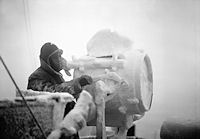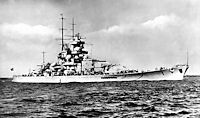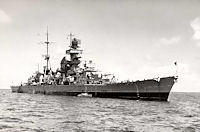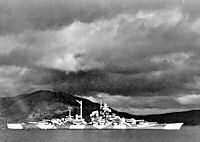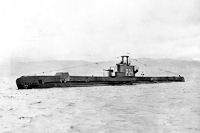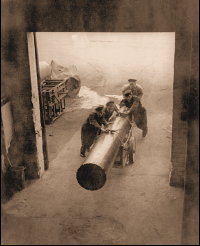
HMS Ambrose
Rubis Photo Gallery Photographs of the Free French Naval Forces submarine Rubis and her crew.
Rubis in Action (Google Map) The map shows the positions of all of Rubis's documented actions.
Rubis Today (Diving Videos) Rubis was scuttled in 1957 off St. Tropez, France, for sonar target practice.
Tribute to Submarines By Winston Spencer Churchill, Prime Minister.
Estuary Panorama (Scrollable Panorama) of the Tay Estuary with wartime points of interest highlighted.
HMS Ambrose
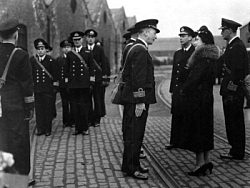
9th Flotilla, (right) with the King and Queen
outside HMS Ambrose.
Dundee had been a submarine base just before the First World War, though the submarines were withdrawn once the new naval base at Rosyth was completed in 1912. But as war clouds gathered again in late summer 1939, and the Royal Navy moved to its war stations, Britain's most modern and powerful submarine flotilla in Home Waters, the 2nd Flotilla, arrived in Dundee.
Even before war broke out, the Dundee boats were patrolling the North Sea, watching for German warships trying to break out into the North Atlantic. Dundee remained a vitally important Allied submarine base for the following six years, the British boats being joined by submarines from Poland, Norway, France and Holland as each of these countries fell under the Nazi heel. Dundee-based submarines played a central role in some of the most daring and important naval operations of the war.
Patrols were maintained perilously close to the enemy-held coastline in all weathers and in defiance of German aircraft and patrol vessels. Enemy warships were attacked, one Dundee submarine heavily damaging the battlecruiser Gneisenau and another blowing the stern off the cruiser Prinz Eugen. Dundee submarines patrolled far inside the Arctic Circle to help protect convoys carrying much-needed war supplies to the Soviet Union, on occasion even dicing with the mighty German battleship Tirpitz.
Enemy convoys carrying supplies and minerals vital to the German war effort were constantly attacked, so much so that the German garrison in northern Norway began to starve and had to be withdrawn. Using ENIGMA intelligence provided by Bletchley Park code breakers, Dundee submarines closed in on U-boats heading for the North Atlantic convoy routes, sinking several before they could attack Allied shipping. And, in support of the resistance in occupied Norway, agents, teams of saboteurs, weapons and supplies were landed under cover of darkness, often deep inside fjords. The Free French Rubis laid minefields and torpedoed enemy merchantmen and warships in Norwegian coastal waters and the Bay of Biscay. Another Free French boat, Minerve, limped back to Dundee badly damaged and leaking after she attacked a convoy and was smashed into the sea bed by depth charges.
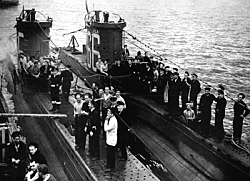
The British boat Satyr scored numerous successes that included sinking a U-boat outbound for patrol from Norway and Venturer, despite what Hollywood would have us believe, remains the only submarine ever to have sunk another while both boats were submerged. And these are but a very few of the tales of remarkable courage and endurance on the part of the Dundee submariners.
All this success came at a cost, however, and six Dundee-based submarines; two British, two Dutch, one Norwegian and one Russian were lost with their crews, some 288 men in all. In addition, seven Norwegian Commandos and one MI6 agent were lost while being taken to Norway in the submarine Uredd. And eight commandos lost their lives as a result of Operation Musketoon, a raid to destroy a power station near Bodø. The Musketoon party was landed by a Dundee submarine and seven of them were captured after the charges had gone off, wrecking the power station. Held briefly at the infamous Colditz Castle, the seven were then taken first to Berlin for interrogation at the hands of the Gestapo and were then taken to Sachsenhausen Concentration Camp where each was executed with a single bullet to the head. Their bodies were thrown into the crematorium ovens.
The Arctic convoys of World War II travelled from the United Kingdom and the United States Soviet ports of Arkhangelsk and Murmansk. Seventy-eight convoys sailed between August 1941 and May 1945.
Of the 1400 merchant ship sailings to Russia, eighty five were lost 85 along with 16 Royal Navy warships. The Germans lost a number of vessels including one battlecruiser, three destroyers and at least 30 U-boats as well as a large number of aircraft.
ULTRA intelligence gained from the cracking of the Enigma code at Bletchley Park played an important part in the success of these convoys.
Gneisenau was a World War II Scharnhorst class capital ship, referred to as either a light battleship or battlecruiser of the German Kriegsmarine. This 31,100-ton ship was the third to carry the name of the Prussian general August von Gneisenau. She usually sailed into battle accompanied by her sister ship Scharnhorst.
In 1942, Gneisenau and Scharnhorst, accompanied by the heavy cruiser Prinz Eugen, and a covering screen of destroyers and torpedo boats, executed a daring daylight run to Germany, Operation Cerberus. All three of the major ships escaped damage in the furious air and sea battles that ensued in the English Channel.
The Prinz Eugen was an enlarged Admiral Hipper-class heavy cruiser which served with the Kriegsmarine of Germany during World War II.
She was named after Prince Eugene of Savoy (Prinz Eugen in German).
Prinz Eugen was the third ship of the Hipper-class heavy cruisers. Like her sister ships, Admiral Hipper and Blücher, she was built in the mid-1930s. During the planning and design stage, she was known as “Kreuzer J” (Cruiser J). Her keel was laid at the Krupp Germania shipyard in Kiel on 23rd April 1936, and her full cost would be 104.5 million Reichsmark.
Prinz Eugen was launched on 22nd August 1938 and commissioned on 1st August 1940. Considered a “lucky ship”, she survived to the end of the war (although she participated in only two major actions at sea). The ship sank following Operation Crossroads atomic bomb tests at Kwajalein Atoll in 1946.
Tirpitz was the second Bismarck class battleship of the German Kriegsmarine, sister ship of Bismarck, named after Admiral Alfred von Tirpitz. She never fired against an enemy ship but spent most of World War II in various bases in German-occupied Norway, where her mere presence was a threat to the Allies, tying up significant naval forces.
Due to her role and bases of operations she was dubbed the “Lonely Queen of the North” (“Den ensomme Nordens Dronning”) by the Norwegians. She was the largest battleship ever built in Europe, with dimensions slightly exceeding those of her sister ship.
In October 1944, as Tirpitz was no longer considered by the Kriegsmarine to be a seaworthy warship, she was moved further south to Tromsø, to act as a floating gun battery against the expected Allied invasion of Norway. This placed her within range of air operations from Scotland.
On 12th November 1944 Royal Air Force Avro Lancaster heavy bombers bombed and sank Tirpitz at her moorings.
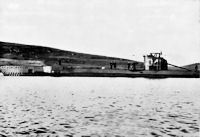
HMS P41 was a Royal Navy U-class submarine built by Vickers-Armstrong. She was transferred to the Royal Norwegian Navy after the Dutch crew for which she was intended were lost when their ship was sunk in the Atlantic. Renamed Uredd (‘Unafraid’) and commissioned on 7th December 1941, she operated with the Norwegian Section of the 9th Flotilla based in Dundee. In addition to her usual patrols off the coast of Nazi-occupied Norway, in one special assignment she dropped off five “Kompani Linge” agents at Bodø for Operation Seagull. She then proceed to Senja to pick up two French submariners left behind by the Free French submarine Junon during an earlier operation to supply the Norwegian resistance.
On her eighth war patrol in February 1943, Uredd, her 34 crew and six agents on their way to Norway were lost when the submarine hit a German mine in Fugleøyfjord, south of Bodø. The wreck of Uredd was found on November 4th, 1985 by the Norwegian submarine Tana and, in 1986, King Olav V unveiled a memorial in Grensen to those lost.
HMS Satyr was an S class submarine of the Royal Navy built by Scotts, of Greenock and launched on September 28th, 1942. Satyr spent much of her wartime career in home waters, sinking the Norwegian merchant Nordnorge and the U-987. Satyr also unsuccessfully attacked the German merchants Bochum and Emma Sauber, and a German convoy off Egersund, Norway.
During 1944–1945 Satyr was disarmed, streamlined and given more powerful batteries to serve as a high speed target submarine. She was lent to the French navy between February 1952 and August 1961, and renamed Saphir. After 20 years of service, she was broken up in April 1962 at Charlestown.
Lieutenant Dick Raikes of the British L-26 wrote of Roper…
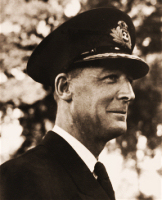
“I know of no one but James Roper who could have so successfully cemented us all together.” Lieutenant Pim Kiepe of the Dutch O-15 wrote, “What made S9 unusual was the fact that it was composed of five nationalities.
Apart from the Royal Navy there were Free French, Norwegian, Polish and Dutch boats. This gave life in the wardroom, and especially during guest nights, a different, cheerful, often amusing atmosphere of camaraderie. You could always count on a Frenchman calling out, “C’est magnifique mais ce n’est pas la guerre,” when sombody was boasting about the delights of his run ashore.
The Brits are very good at running such a diverse collection of Allies, they always seem to hit the right note. For instance, Captain S/M would always invite the CO for dinner the night before the boat went on patrol. If it was a Free French boat he would drink Pernod and wine, with a Norwegian aquavit, with the Poles vodka, and the Dutch Jenever…”
